Rock and an Old Place
A Family Farm Rich in History Faces the Relentless March of Natural Gas Drilling

Denise Dennis ’72 (foreground), with her brother Darryl Gore ’79, are worried that gas drilling in the Marcellus Shale threatens their historic family farm in Pennsylvania.
Hop Bottom, Susquehanna County, population 330, is the kind of leafy Pennsylvania hamlet where old men sit on benches in front of the country store, watching the world go by. There’s no cell-phone service, let alone a Starbucks. “Up until two years ago, if you saw three cars together it had to be a funeral,” says one local, nodding toward Main Street.
That world has changed. On a weekday summer morning, the still air echoes with the rumble of heavy trucks: dump trucks and tankers and flatbeds hauling massive equipment. Just up the ridge, cows and horses—and their human neighbors—are getting used to the constant thrum of the drilling rigs and the bright lights that illuminate the well pads through the night. Gangs of hard-hatted workers are clearing land and digging trenches, laying miles of 12-inch pipeline across forest and pasture.
Similar scenes are playing out across the state and beyond, the opening act in an energy boom the likes of which Pennsylvania hasn’t seen since the advent of coal. But for Denise Dennis ’72, Hop Bottom is where it all comes home. A mile down the road, tucked between smaller parcels on a hill above the creek, is the 153-acre farm that has belonged to her family for seven generations.
Prince Perkins, Dennis’ great-great-great-great-grandfather, brought his family to this valley from Connecticut in 1793. He and his wife, Judith, were among the first settlers here. More significantly, they were African Americans—free blacks who lived and prospered in this still overwhelmingly white place 70 years before emancipation. “At a time when slavery was the law of the land, they owned property here,” Dennis says. “They were part of the community. This is an American story that doesn’t get told.”
In 2001, she and her aunt Hope Dennis established the Dennis Farm Charitable Land Trust to preserve Prince Perkins’ legacy. The farm has since been recognized by the National Trust for Historic Preservation and the Smithsonian Institution. Denise Dennis has been working toward making it into an educational and cultural center, “a place where people can come and experience a tangible reminder of a unique part of history.”
But that vision is threatened. Most of Dennis’s neighbors have sold the rights to drill for the natural gas beneath their land. Well pads are beginning to dot the countryside. Dennis fears the rustic landscape will be spoiled, but most of all she’s concerned about water—the danger that an intensely industrial process will pollute the pristine supply the area has enjoyed for centuries.
“It’s ironic, of course,” she muses. “That’s why people settled here in the first place. For the water.”
What Lies Beneath
Deep below the surface of more than half of Pennsylvania, running southwest to northeast, lies the Marcellus Shale, an immense and ancient mass of sedimentary rock that stretches from West Virginia to New York.
Formed of decayed organic material, the shale is rich in hydrocarbons, in the form of natural gas. This gas is not, however, contained in pockets but actually infused throughout the rock: it can’t be extracted by conventional vertical drilling but needs a much more expensive horizontal approach. Until recently, therefore, the Marcellus play, as gas explorers call it, was deemed to offer insufficient return on investment.
In January 2008, however, geophysicists Terry Engelder of Penn State and Gary Lash of the State University of New York at Fredonia, after re-analyzing fracture patterns present in the shale, released a drastically revised estimate of the amount of gas the Marcellus might yield. According to these two experts, the formation contained up to 500 trillion cubic feet of the stuff, making it one of the largest deposits in the world. By a combination of horizontal drilling and a technique called hydraulic fracturing, Engelder and Lash projected, the Marcellus Shale could be made to produce a trillion dollars worth of gas.
The immensity of this resource, combined with its proximity to East Coast markets, made it an irresistible target for development. Almost immediately, energy companies commenced the gas rush that has since galvanized large swaths of the state. Natural gas, proponents say, is manna from heaven, the key to our transition from fossil fuels to renewable alternatives: It burns cleaner than coal, and a huge domestic cache of the stuff could spring us from reliance on foreign oil. Equally enticing for a state squashed flat by recession is the economic potential. Engelder has called it “beyond imagination.”
A report published last year by energy economists at Penn State projected that by 2020 gas development could create more than 200,000 jobs and pump $19 billion into the state’s economy. That study has been blasted by critics who point to its funding by the gas industry and call its numbers “wildly optimistic,” but some early impacts of development are undeniable. Gas companies paid $1.8 billion for drilling leases to Pennsylvania property owners in 2009, and that number is expected to top $6 billion by the end of 2011.
Meanwhile, though, local communities are experiencing what sociologists call “boomtown effects”: damage to roads, strains on services, housing shortages—all caused by the blitzkrieg of heavy industry. There is real concern that true job gains will remain elusive, as skilled positions continue to be filled by out-of-state workers. Moreover, critics argue, whatever the economic gains gas drilling may provide, they will come at too high a cost to the region’s environment.

Marcellus Shale
Sandblasting for Gas
The crux of contention is the deep-well extraction process known as hydraulic fracturing, or fracking.
It’s a complex and difficult process, but the concept is simple. After standard vertical drilling has penetrated the shale layer more than a mile below the surface, the drilling continues horizontally, into the meat of the deposit. Once enough surface is gained, the drill is removed and fluid is jetted into the L-shaped well at extremely high pressure. Its force opens up existing cracks in the shale, allowing trapped gas to escape and flow back up the well.
Fracking requires tremendous amounts of water—anywhere from a million to 10 million gallons per well over the 10- to 15-year life of the well. This water is drawn from nearby rivers or streams and trucked to the well pad, there to be mixed with sand, used to prop open the tiny fractures, and a host of chemicals added to reduce friction and prevent algae and corrosion.
Although these additives exist in very small concentrations, typically between 0.05 and 0.5 percent of the total fracking fluid, they include many compounds known to be hazardous—ammonium bisulfite, ethylene glycol, isopropanol, formaldehyde, among others. The precise ingredients have been guarded as trade secrets.
In its course, too, fracking fluid dissolves heavy metals, salts, even small amounts of arsenic and lead from underground rock. Much of this fluid remains below, but 30 to 40 percent of it returns to the surface as flowback. The end result is great volumes of contaminated wastewater whose safe disposal, to put it mildly, presents significant challenges.
It was these issues that first attracted Swarthmore’s Environmental Studies (ENVS) students to the Marcellus Shale. As this spring’s capstone experience for the ENVS minor, Carol Nackenoff, professor of political science, had fashioned a seminar on environmental justice, with the theme of fresh water. “The availability of fresh water supplies is a very big issue for the next century,” she explains. “That availability is threatened in many places around the globe.”
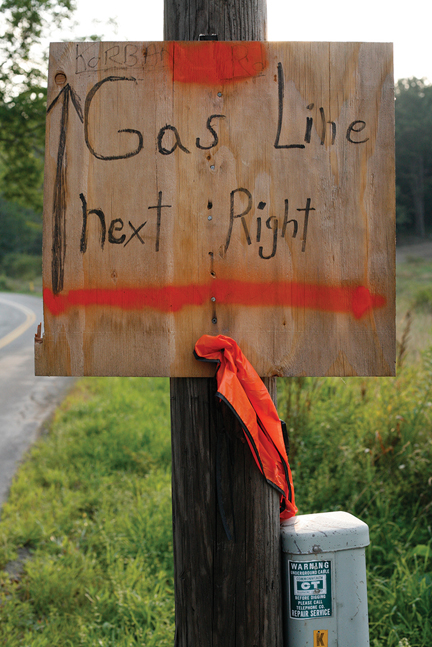
Directions to the gas line.
Other faculty members were also interested in the Marcellus gas play. Professor of Physics Peter Collings had given an informal faculty presentation on fracking and, in February, talked with Nackenoff’s capstone students and Professor of Philosophy Hans Oberdiek’s environmental ethics class in a joint meeting of the two courses.
One of those places, according to opponents of natural gas extraction, is the Delaware River Basin, source of drinking water for some 16 million people in New York, Pennsylvania, New Jersey, and Delaware. As gas companies have begun to explore drilling in the upper region of the basin, activists warn, they create a real threat of downstream contamination impacting Philadelphia and New York.
On Swarthmore’s campus this spring, other environmental causes were more visible. Earthlust, the student environmental organization, had focused its efforts on mountaintop removal coal mining in West Virginia. But, “We wanted to focus on something that affected our immediate area,” says Claudia Seixas ’10, a member of the capstone seminar. While struggling to negotiate the complex of issues surrounding Marcellus drilling, she and her classmates decided to create a website that would gather information about its economic, environmental, legal, and regulatory aspects. “We wanted it to be accessible to landowners, and to any Pennsylvania citizen who was interested,” says Seixas. “But we also wanted it to be a resource for the College.”
Like Oil and Water
As the semester unfolded, local activists stepped up their efforts. “There were events in Philadelphia every week,” remembers Nackenoff. One flashpoint was the attention garnered by the film Gasland at January’s Sundance Festival. Its director, Josh Fox, grew up in Milanville, Pa., on the upper Delaware. Excoriated by the gas industry as biased and unfair, Fox’s Michael-Moore-style exposé of methane-contaminated drinking water and unexplained illnesses made Dimock, Pa., five miles down the road from Hop Bottom, synonymous with the dangers of fracking.
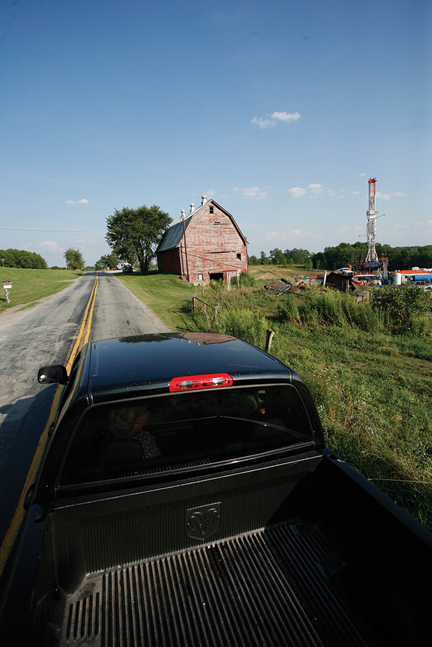
The economic incentives for rural Pennsylvania’s families are great: up to $2,500 per acre for mineral leases. That’s a quarter-million dollars for a 100-acre dairy farm. But some residents are wondering whether the drilling is worth the environmental cost.
Alice Zinnes ’77, an artist and professor of studio art in New York, has a second home in Milanville. As a neighbor of Fox’s, she had seen clips of Gasland early in production. This and other experiences spurred her to become more and more active in the Damascus Citizens for Sustainability, a grassroots anti-drilling group that has become a leader of the opposition. In June, Zinnes organized Art for Water, a New York gallery show and auction that raised more than $10,000 for the group’s legal fund. “It started for me as a kind of NIMBY thing,” she says. “There’s a well pad I can almost see from my window. But it has just mushroomed. There is drilling going on in 34 states. I’m very concerned about the destruction of the planet.”
Drilling’s backers, citing a 2004 report by the Environmental Protection Agency (EPA), hold that fracking is harmless. Because it takes place a mile below the water table, they say, with several geologic layers in between, contamination of groundwater by fracking chemicals is simply impossible. Industry spokesmen claim there has never been a case of contamination directly tied to fracking.
Zinnes and other opponents dispute these claims. The EPA report, they say, was politically influenced and narrow in scope. Fracking’s impacts, they argue, have never been comprehensively studied. Cornell geophysicist Anthony Ingraffea, an expert on rock fracture mechanics who has called for a moratorium on drilling, agrees that the probability of fracking chemicals migrating from that depth up into the water supply is very low. But to call it impossible, he says, is “nonsense. Nobody really knows the geology down there.”
Moreover, Ingraffea points to the greater probability of other mishaps: well-casing failures and surface spills. The latter, it would seem, have been far more common than the industry admits: An investigative report published in June in the Scranton Times Tribune turned up “hundreds of spills at well pads over the last five years,” most of them not publicized. And because the 2005 Energy Act expressly exempts fracking from the purview of the federal Clean Drinking Water Act—the so-called “Halliburton loophole”—
oversight of such incidents falls to the state level. In practice, because state regulations are antiquated and uneven and state agencies grossly understaffed to enforce them, that means heavy reliance on industry self-policing.
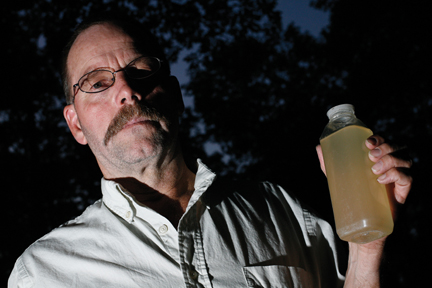
Craig Sautner of Dimock, Pa., (top) holds a bottle of contaminated water collected from his tap in March 2010. The water problems started in September 2008 after natural gas drilling began on his property a month before. “In our water, we’ve found aluminum, manganese, chloride, iron, magnesium, sodium, strontium-T—all above the EPA limits,” Sautner says.
For the capstone students, one of the biggest concerns was wastewater. In the arid west, frack flowback is routinely disposed of via large evaporation pits or deep-well injection, options that both climate and geology make impossible in Pennsylvania. Here, flowback is either partially treated and released back into streams, trucked elsewhere, or stored temporarily in large ponds (“because they don’t know what to do with it,” says Ingraffea). There’s a movement now toward recycling fluid from well to well, but ultimate disposal remains unsolved.
In the Shadow of the Gulf
Along Carter Road in Dimock, a daily truck brings water to 14 families whose drinking water wells are polluted with methane. Cabot Oil and Gas, the company held responsible by the Pennsylvania Department of Environmental Protection, has “had at least 21 spills in Dimock township in less than two years,” according to the Times Tribune: One dumped 8,400 gallons of frack fluid at a well site, another 1,900 gallons into a wetland and creek. In May, agriculture officials quarantined 28 beef cattle on a Tioga County farm after wastewater from a gas well leaked into their pasture. And in June, a blowout at a well in Clearfield County spewed gas and wastewater into nearby streams for 16 hours before it could be capped.
These incidents, blinking in the shadow of the Gulf oil disaster, have heightened public anxiety about gas drilling. Hearings across the Marcellus region have drawn large and vocal crowds, in some cases pitting pro-drilling landowners (“Pass the Gas!”) against environmental activists (“No Fracking Way!”). The grassroots howl has reached the ears of lawmakers: In June 2009, Democratic members of Congress including Pennsylvania’s Robert Casey Jr. introduced the so-called FRAC Act, which would give the EPA authority over hydraulic fracturing and force gas companies to disclose the chemicals they use. This spring, the EPA announced over industry protests that it will undertake a broad study of the possible impact of fracking on drinking water quality, one which unlike previous efforts will consider the entire “life-cycle” of the well.

The Sautners’ well has so much methane that Craig can sometimes light his water on fire, and the drilling company had to install an exhaust pipe to vent off excess methane.
The Delaware River Basin Commission, the interstate compact that holds legal authority over water quality in the Delaware River Basin, has called a halt to drilling while it works out comprehensive regulations governing Marcellus Shale activity. New York, too, has imposed a moratorium while it adopts its own regulations.
Meanwhile, however, across much of Pennsylvania, drilling continues apace. And it’s that pace, more than anything, which troubles the capstone students. For Jesse Marshall ’11, an honors political science major looking toward a career in public policy: “It feels more like a gold rush right now than like decision-making in an era of modern environmental regulation. Things need to slow down.”
Zach Eichenwald ’10, now pursuing a master’s degree in environmental engineering at the University of California at Berkeley, has similar concerns. “Based on what I have learned,” he says, “shale gas drilling is not necessarily any worse than other methods of drilling or mining, and in many cases it actually has less of an impact on human and environmental health.” However, Eichenwald adds, “the lack of regulatory
control is certainly troubling.”
For Claudia Seixas ’10, an art history major with history and environmental studies minors who is now an Americorps volunteer, “It’s important to take time to look at all sides of the issue. Once you ruin a water supply,” she says, “you ruin a community. You can’t really go back.”
Future Past
On a well pad above Hop Bottom, the foreman is wary but polite, warning visitors without hard hats to keep off the premises. Like the handful of workmen staring down from the deck of the drill rig, he’s a Texan. A pick-up truck parked nearby is flying a Confederate flag. The gas companies are just beginning to move in here. They have already bought up most of the township’s mineral rights, but as yet only two wells are active, both of them still at the drilling stage. They have yet to commence the intense business of fracking, with hundreds of tankers hauling water to each site for every well.
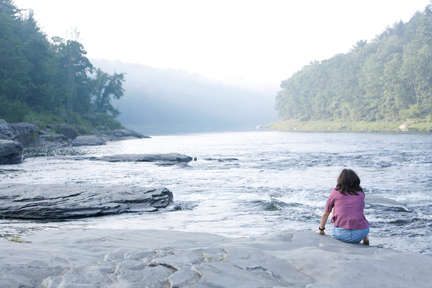 It’s hard to imagine what this place might look like five years from now—and equally difficult to picture the future of Dennis Farm. Today, in high summer, the farm is thickly overgrown with weeds and brush, a strategy for deterring vandals. But Denise Dennis, a long-time journalist who writes and lectures about black history, can still see its past. “This is a place I love,” she says. “It’s like a living, breathing person to me. But it’s not only what it means to me and my family. It’s what it symbolizes.”
It’s hard to imagine what this place might look like five years from now—and equally difficult to picture the future of Dennis Farm. Today, in high summer, the farm is thickly overgrown with weeds and brush, a strategy for deterring vandals. But Denise Dennis, a long-time journalist who writes and lectures about black history, can still see its past. “This is a place I love,” she says. “It’s like a living, breathing person to me. But it’s not only what it means to me and my family. It’s what it symbolizes.”
Gas company representatives have offered the Land Trust $800,000 for the rights to drill here. The money is tempting—the old farmhouse is crumbling, and the family cemetery is littered with broken tombstones—but for Dennis the risk is too great. By allowing drilling, she fears, she would spoil the very thing she seeks to save. And as she well knows by now, it may be ruined anyway.
“It was going to be this wonderful place,” she says, speaking of her dream in the past tense. At other times, the determination of her pioneer ancestors rises in her voice. “We’re proceeding with what we’re doing,” Dennis says firmly.
“I’m no hero. I don’t like being put in this position. But after 200 years, I have a responsibility to those who came before me. I can’t stand back and let it end this way.”
David Pacchioli is a writer who lives in State College, Pa.
 Michael Forster-Rothbart ’94 is a photojournalist whose projects explore the human impacts of environmental change. On a Fulbright Fellowship, he spent two years in Chernobyl, documenting why people stayed after their homes become contaminated. His After Chernobyl exhibit will be displayed in McCabe Library in 2011. He now photographs for educational institutions and lives in New York.
Michael Forster-Rothbart ’94 is a photojournalist whose projects explore the human impacts of environmental change. On a Fulbright Fellowship, he spent two years in Chernobyl, documenting why people stayed after their homes become contaminated. His After Chernobyl exhibit will be displayed in McCabe Library in 2011. He now photographs for educational institutions and lives in New York.
 Email This Page
Email This Page
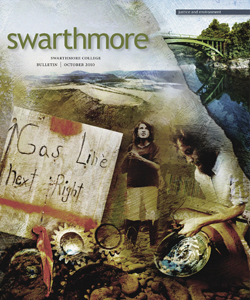
November 15th, 2010 4:45 pm
I got the following letter from Denise Dennis the other day. Thanks, Denise!
October 31, 2010
Jeffrey Lott, Editor
Swarthmore Bulletin
Dear Jeff,
Thank you for including the Dennis Farm in the thought-provoking, October edition of the Swarthmore Bulletin. When I was a student at the college, we talked a great deal about “consciousness raising” and now the Bulletin has helped raise the readers’ consciousness about urgent environmental issues and justice. The environment is indeed as much an ethical, social and spiritual issue as it is a scientific and economic one—and it deserves to be approached from each of these perspectives.
I appreciate the need for alternative energy sources and am for progress–but for progress that doesn’t do more harm than good. Before we—as a national and world community—continue to pursue natural gas, serious risk assessment and cumulative impact studies on the long-term effects of horizontal hydraulic fracturing need to be done.
The gas/oil industry is now wreaking havoc on the Marcellus Shale region—and the citizens who live there–as it has done in developing countries whose natural resources they covet. Private, tax-paying landowners in Pennsylvania are regarded by the industry as nothing more than inconvenient obstacles to be either bought, forced to lease, or risk having gas extracted from their property without their consent.
In case Bulletin readers are interested in what I’ve been up to since David interviewed me for the article, here is an update:
In September, I testified at hearing convened by Philadelphia City Council, under the auspices of Councilman Curtis Jones, to determine whether or not to issue permits to drill in the Delaware River basin (which supplies one-hundred percent of drinking water for the greater Philadelphia region.) Several people testified over six-hours, including scientists and representatives from the industry and there were approximately two-hundred spectators, organized by local environmental groups. My testimony received a standing ovation, the only one of the day. Having heard the industry’s arguments so many times and having researched their claims, I was able to point-by-point demonstrate where they have been prevaricating or shading the truth. For example, in spite of their claims that drilling provides jobs, Secretary Hanger of the DEP admitted to me that the majority of industry jobs are going to transient workers from out of state, not Pennsylvanians. Another industry claim is that fracking does not cause methane migration to water wells and aquifers. Yet, the industry knows that drilling itself releases methane, which then migrates to wells and aquifers. I’ve attached a copy of my testimony for you with this letter.
The outcome of the hearing was that, the following day, City Council passed a resolution calling for a three-year statewide moratorium on gas drilling until cumulative impact studies are done. Unfortunately, the state legislature does not listen to Philadelphia City Council.
In October, I spoke at a press conference in the Capitol rotunda in Harrisburg expressing my opposition to forced pooling. As current Pennsylvania law now stands, forced pooling in the Marcellus Shale is illegal. Forced pooling (which the industry has attempted redefine as “fair” pooling and “conservation” pooling) would enable a gas company to extract gas from a property without the landowner’s consent; and after extracting the gas, to pay the landowner royalties at a rate determined by the company minus a 400 percent deduction for the cost of the well pad. This is tantamount to land theft. Two state representatives have proposed legislation to legalize forced pooling. By the legislators’ own admission, their proposed legislation was written by the industry.
In mid-October, I participated in a summit sponsored by the Endless Mountains Heritage Region in Towanda, Bradford County. We discussed gas drilling during an evening roundtable and residents expressed their concern about the changes in their quality of life now that “the drillers” have descended on them. They are still hopeful that gas companies will do the right thing. As I listened to them, I understood how easy it has been for “land men” who represent the gas companies to mislead local people about the impact of drilling.
As Dave reported, water trucks carrying frack fluid and drilling equipment now rumble along the highways in this otherwise bucolic region. I could hear then all night from my room in Towanda’s Bradford Inn. The trucks were a jarring contrast to the magnificent fall foliage in the vast Endless Mountains. At one point, our archaeologist Wade Catts who also spoke at the Summit, and I were driving behind a truck that said “Well Pad Driller” and passed a huge truck with the name Schulemberger, the French company that is a shareholder in Cabot, written in tall letters on the side. Gas drilling in the Marcellus Shale is an environmental holocaust.
I frequently remind myself that my ancestors on the farm lived through worse. After all, in 1793, the year they moved to Pennsylvania from Connecticut–as free people, Congress passed the first Fugitive Slave Act that placed not only fugitive slaves—but free African Americans, too—at risk of being kidnapped. In 1837, the Pennsylvania Supreme Court disenfranchised black men who, since the American Revolution, had the right to vote in the Commonwealth. They could not vote again until 1870. Northeastern Pennsylvania was a fervent center of abolitionist activity. Today, my fellow landowners upstate are white, but I’ve told them that if the region could help end slavery–another immoral industry disguised as an economic necessity–we can push back against the gas industry, too.
The United States is facing a water shortage. If we do not regulate gas drilling, which requires 2-5 million gallons per well to frack, and contaminates aquifers; and, if we do not demand that industry scientists go back to the drawing board and find a safe method for extracting gas from deep shale, we might end up having to import water–for all our needs–as we now import oil. Imagine that!
By the way, Alice Zinnes and I have become friends through our mutual quest to save our land, air and water; we share information and encouragement several times a week.
Thank you, again. The Bulletin is Swarthmore at its best.
Warm regards,
Denise